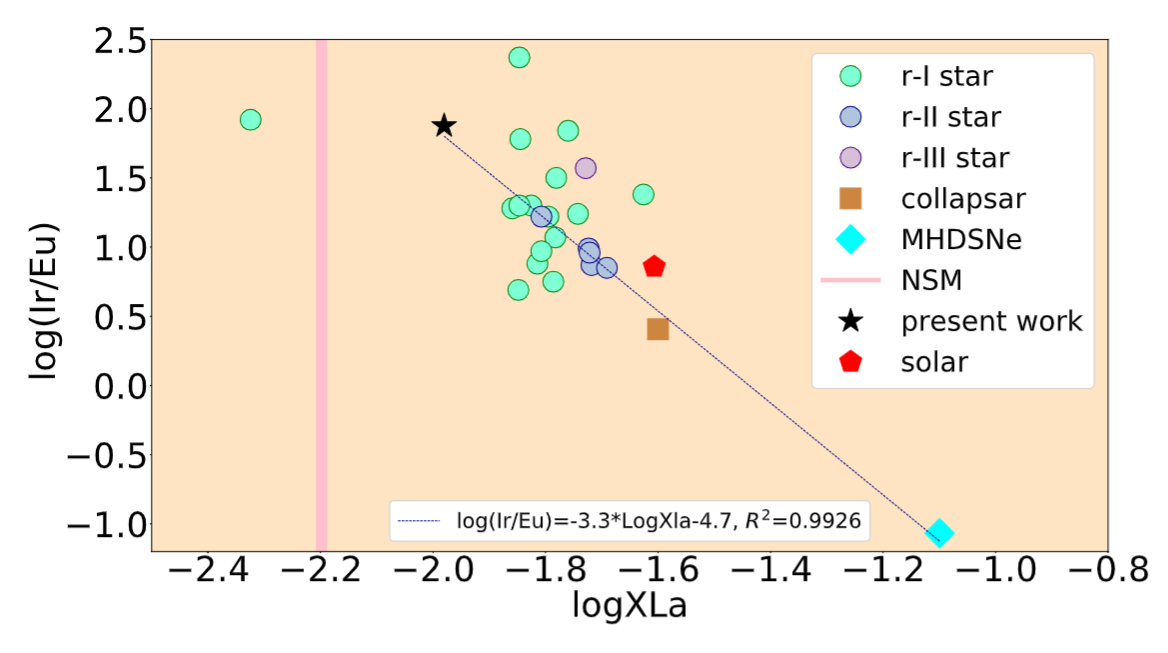Novel Features of R-process Nucleosynthesis Sheds Light on Origin of Heavy Elements

Fig 1. Artistic representation of Common Envelop Jet Supernovae (Image by IMP)
In a recent study published in The Astrophysical Journal on August 20, scientists have proposed the features of the rapid neutron capture process (r-process) nucleosynthesis in a novel scenario, Common Envelop Jet Supernovae (CEJSNe). The study sheds new light on the origin of elements, especially beyond the lanthanides.
The origin of elements heavier than iron is one of the key questions in the physics community. Fusion burning in the stars produces elements up to iron while heavier ones are not able to be reached due to the Coulomb repulsion. However, the explosive environment could offer enough temperature and density to generate them. The r-process occurring in such environment is believed to produce about half of the elements heavier than iron.
In 2017, the discovery of the gravitational wave and its afterglow of the neutron star merger event GW081708 uniquely confirmed the occurring of the r-process for the first time. However, subsequent studies cast doubt on that the neutron star merger is the only site of r-process, as the abundance of lanthanides produced by the neutron star merger is significantly less than what have been observed in metal-poor stars. Therefore, the roles of other sites, like the collapsar and the Magneto Hydrodynamics Supernovae, should be irreplaceable in r-process.
Dr. JIN Shilun, from the Institute of Modern Physics (IMP) of the Chinese Academy of Sciences (CAS), and his collaborator from Technion, Israel, presented the features of r-process in the novel site CEJSNe for the first time.
CEJSNe refers to a neutron star remnant of the supernova and a red supergiant from the late phase of a massive binary system. The red supergiant expands and engulfs the neutron star, which spirals-in inside the red supergiant's envelop and then inside its core. Once entering the core, the neutron star accretes mass via an accretion disk at a very high rate, and the energetic and dense jets that are produced can provide proper conditions for r-process nucleosynthesis.
The study indicates that CEJSNe can produce the most abundant elements heavier than lanthanide among current r-process scenarios. By comparing the Log(Xla) Vs Log(Ir/Eu), which is a new quantity to show the relative strength of lanthanide and elements in the third peak, researchers found the anti-correlation between CEJSNe and other r-process models.
"This finding means that abundant lanthanide and heavier elements can't be generated in a single event, which would be a critical feature for further research on r-process. CEJSNe is also critical for explaining the characteristics of the r-enhanced metal-poor stars," said JIN.
This work not only paves a new way for better understanding the secrets hidden in r-process, but also guides experimentalists for various measurements. As exotic isotopes from the High Intensity Accelerator Facility (HIAF) will be available soon in China, the key nuclear properties relevant to the r-process in CEJSNe are expected to be unveiled in the future.
This work is supported by National Natural Science Foundation of China, Light of West China Program of CAS, CAS Project for Young Scientists in Basic Research and the Israel Science Foundation.

Fig 2. Log(Xla) VS Log(Ir/Eu) of r-enhanced stars and scenarios of CEJSNe, the magneto hydrodynamics supernovae, the collapsar and the neutron star merger. (Image by JIN Shilun)
DOI: https://doi.org/10.3847/1538-4357/ad5f8e
Contact Information
Institute of Modern Physics
Email: LIU Fang


 甘公网安备 62010202000713号
甘公网安备 62010202000713号


